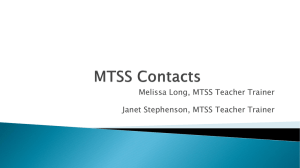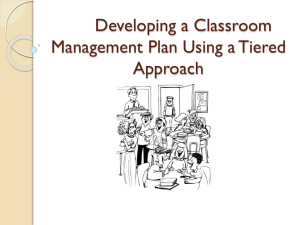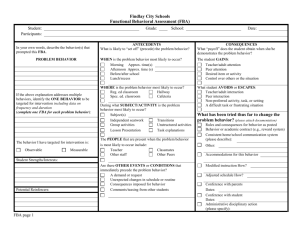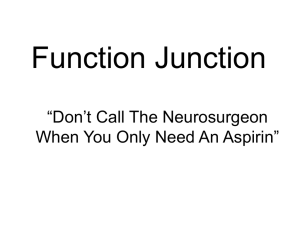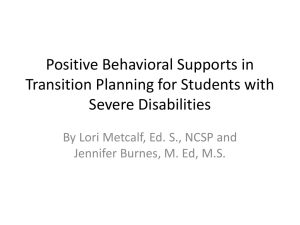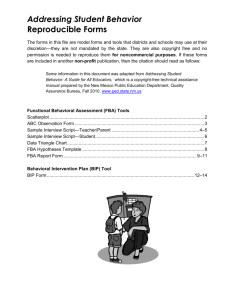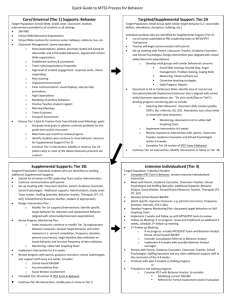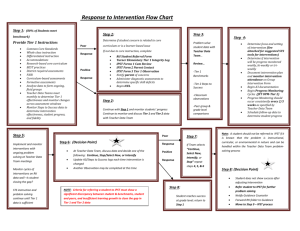Glossary of Terms used in IPST Forms
advertisement
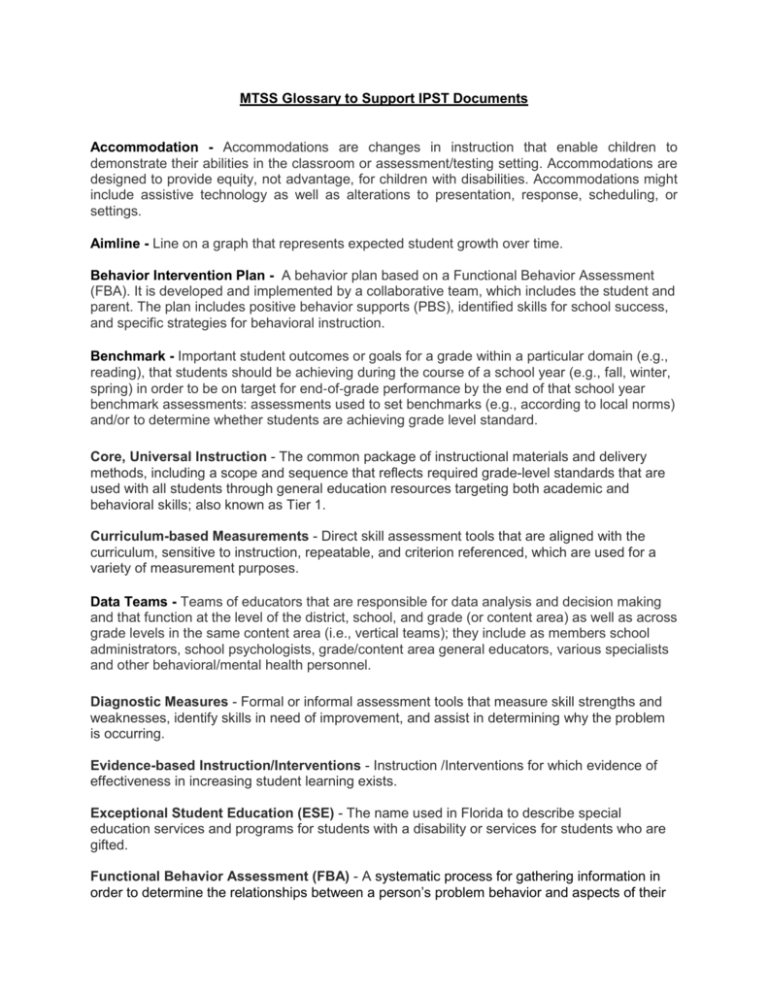
MTSS Glossary to Support IPST Documents Accommodation - Accommodations are changes in instruction that enable children to demonstrate their abilities in the classroom or assessment/testing setting. Accommodations are designed to provide equity, not advantage, for children with disabilities. Accommodations might include assistive technology as well as alterations to presentation, response, scheduling, or settings. Aimline - Line on a graph that represents expected student growth over time. Behavior Intervention Plan - A behavior plan based on a Functional Behavior Assessment (FBA). It is developed and implemented by a collaborative team, which includes the student and parent. The plan includes positive behavior supports (PBS), identified skills for school success, and specific strategies for behavioral instruction. Benchmark - Important student outcomes or goals for a grade within a particular domain (e.g., reading), that students should be achieving during the course of a school year (e.g., fall, winter, spring) in order to be on target for end‐of‐grade performance by the end of that school year benchmark assessments: assessments used to set benchmarks (e.g., according to local norms) and/or to determine whether students are achieving grade level standard. Core, Universal Instruction - The common package of instructional materials and delivery methods, including a scope and sequence that reflects required grade-level standards that are used with all students through general education resources targeting both academic and behavioral skills; also known as Tier 1. Curriculum-based Measurements - Direct skill assessment tools that are aligned with the curriculum, sensitive to instruction, repeatable, and criterion referenced, which are used for a variety of measurement purposes. Data Teams - Teams of educators that are responsible for data analysis and decision making and that function at the level of the district, school, and grade (or content area) as well as across grade levels in the same content area (i.e., vertical teams); they include as members school administrators, school psychologists, grade/content area general educators, various specialists and other behavioral/mental health personnel. Diagnostic Measures - Formal or informal assessment tools that measure skill strengths and weaknesses, identify skills in need of improvement, and assist in determining why the problem is occurring. Evidence-based Instruction/Interventions - Instruction /Interventions for which evidence of effectiveness in increasing student learning exists. Exceptional Student Education (ESE) - The name used in Florida to describe special education services and programs for students with a disability or services for students who are gifted. Functional Behavior Assessment (FBA) - A systematic process for gathering information in order to determine the relationships between a person’s problem behavior and aspects of their environment. Through FBA, it is possible to identify specific events that predict and maintain behavior and design a support plan that effectively addresses those variables. FBA methods can, and should, vary across circumstances, but typically include record reviews, interviews, and direct observation. Individual Educational Plan (IEP) - A written plan to identify the annual goals and objectives and special education and related services designed to meet the individual needs of a student with a disability. The IEP is developed by teachers, parents, the student, and others, as appropriate, and is reviewed annually. Individual Problem Solving Team (IPST) - This multidisciplinary, instruction –driven team assists students, families and teachers in seeking positive solutions for all students. Through examination of prior intervention data and all relevant cumulative history they problem-solve at the most intense level. This multidisciplinary, instruction –driven team assists students, families and teachers in seeking positive solutions for all students. The primary goal of the IPST is to support teachers and parents by generating effective academic and behavioral strategies for individual targeted students. Intensity - Intensity consists of three variables: time, focus, and group size. An increase in intensity would be reflected by an increase in the amount of time a student(s) would be exposed to instruction/intervention and/or a narrowing of the focus of instruction/intervention and/or a reduction in group size. Intensive, Individualized Instruction - This is the most “intensive instruction” a building can offer. This level of academic and/or behavioral intervention is characterized by increased length, frequency, and duration of implementation for students who struggle significantly. This is often associated with narrowest tier of an RTI tiered model; also referred to as Tier 3. Interventionist - The person identified as responsible for delivering instruction or intervention in accordance with the team’s intervention plan. Interventions - Curricular, instructional, and/or other adjustments made to address core instructional issues outside of the main time period of instruction. Interventions may also be provided to students in small groups or individually, in addition to and aligned with core instruction in order to target a specific skill or concept. Multi-Tiered System of Supports (MTSS) - A term used to describe an evidence-based model of schooling that uses data‐based problem‐solving to integrate academic and behavioral instruction and intervention. The integrated instruction and intervention is delivered to students in varying intensities (multiple tiers) based on student need. “Need‐driven” decision‐making seeks to ensure that district resources reach the appropriate students at the appropriate levels to accelerate the performance of ALL students to achieve and/or exceed proficiency. Ongoing Progress-Monitoring (OPM) - Ongoing assessment conducted for the purposes of guiding instruction, monitoring student progress, and evaluating instruction/intervention effectiveness. Poor Response to Instruction/Intervention - Student rate of progress data reveals that the gap continues to widen with no change in rate after the instruction/intervention is implemented. Positive Response to Instruction/Intervention - Student rate of progress data reveals that the gap between expected performance and observed performance is closing. Ideally, the point at which the target student will “come in range” of grade-level expectations—even if it is this long range—can be extrapolated. Problem Solving – The recursive, self-correcting, systematic process of finding solutions by accurately identifying problems, analyzing relevant data to understand why the problem is occurring, designing and implementing probable solutions, and measuring the effectiveness of the solutions that were implemented. Problem Solving Team – Any team that systematically engages in the process of accurately identifying problems, analyzing relevant data to understand why the problem is occurring, designing and implementing probable solutions, and measuring the effectiveness of the solutions that were implemented. Progress Monitoring Plan (PMP) – A written plan for individual students, or groups of students, that reflects the interventions provided and the students’ response to those interventions with student-centered data resulting in ongoing progress-monitoring measures at a frequency appropriate to the level of intervention. Progress Monitoring Tool – An assessment used to collect data over time to determine the effectiveness of an intervention or instruction. Questionable Response to Instruction/Intervention – Student rate of progress data reveals that the rate at which the gap is widening is decreasing considerably, but is still widening, or when a gap stops widening but closure does not occur. Rate of Progress – This is typically the amount of growth (e.g., words correct per minute, level of compliance) over a specified time period (week, month) demonstrated by a student or group of students. RIOT/ICEL Table (IPST Form 6 Academic) - The RIOT/ICEL matrix is a guide for problem analysis, in which information is gathered in the domains of instruction, curriculum, environment, and learner (ICEL) through the use of reviews, interviews, observations, and tests (RIOT) in order to evaluate underlying causes of a problem and to validate hypotheses. Time spent in problem analysis increases the likelihood that the resulting intervention will be successful. The RIOT/ICEL matrix is not itself a data collection instrument. Instead, it is an organizing framework, or heuristic, that increases schools’ confidence both in the quality of the data that they collect and the findings that emerge from the data. Targeted, Supplemental Instruction – This is what “some” students receive in addition to Core Universal Instruction. The purpose of Targeted Supplemental Instruction is to improve student performance in Core Universal Instruction. These services are more “intense” (more time, narrow focus of instruction/intervention) than Core Universal Instruction. The delivery of Targeted Supplemental Instruction is focused on skills that pose a barrier to the acceleration of student learning; also known as Tier 2. Universal Screening Measures – A quick check of all students’ current levels of performance in a content or skill area. This is administered three times per year.


